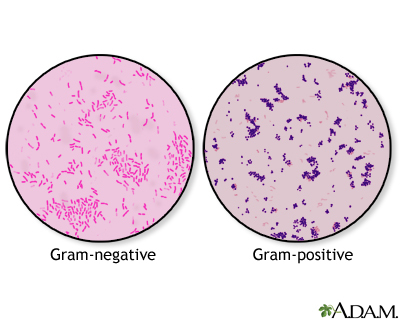Gram stain of urethral discharge
Definition
A Gram stain of urethral discharge is a test used to identify bacteria in fluid from the tube that drains urine from the bladder (urethra).
Alternative Names
Urethral discharge Gram stain; Urethritis - Gram stain
How the Test is Performed
Fluid from the urethra is collected on a cotton swab. A sample from this swab is applied in a very thin layer to a microscope slide. A series of stains called a Gram stain is applied to the specimen.
The stained smear is then examined under the microscope for the presence of bacteria. The color, size, and shape of the cells help identify the type of bacteria causing the infection.
How to Prepare for the Test
This test is often performed in the health care provider's office.
How the Test will Feel
You may feel pressure or burning when the cotton swab touches the urethra.
Why the Test is Performed
The test is performed when an abnormal urethral discharge is present. It may be performed if a sexually transmitted infection is suspected.
Normal Results
Normal value ranges may vary slightly among different laboratories. Some labs use different measurements or test different samples. Talk to your provider about the meaning of your specific test results.
What Abnormal Results Mean
Abnormal results may indicate gonorrhea or other infections.
Risks
There are no risks.
Considerations
A culture of the specimen (urethral discharge culture) should be performed in addition to the Gram stain. More advanced tests (such as PCR tests) may also be done.
Gallery


References
Babu TM, Urban MA, Augenbraun MH. Urethritis. In: Bennett JE, Dolin R, Blaser MJ, eds. Mandell, Douglas, and Bennett's Principles and Practice of Infectious Diseases. 9th ed. Philadelphia, PA: Elsevier; 2020:chap 107.
Swygard H, Cohen MS. Approach to the patient with a sexually transmitted infection. In: Goldman L, Schafer AI, eds. Goldman-Cecil Medicine. 26th ed. Philadelphia, PA: Elsevier; 2020:chap 269.